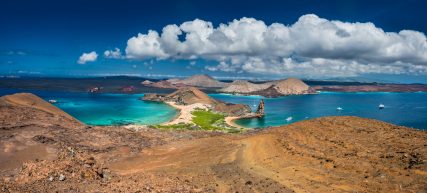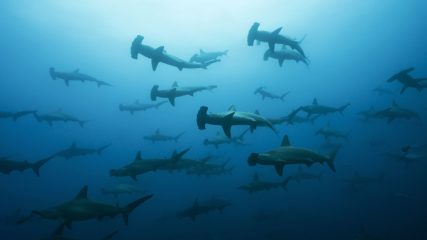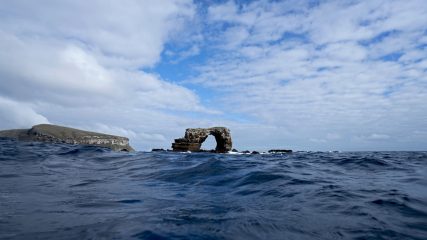Diving in the Galápagos Islands

Found some 600 miles (900 kilometres) off the western coast of Ecuador, the Galápagos Islands are an isolated wildlife realm, cut off for millennia from the rest of the South American continent. Perched on the Equator, this group of 13 major islands and seven islets has provided one of the most astounding and ecologically significant havens for wildlife for thousands of years. The Galápagos are home to a dazzling array of weird and wonderful species, the unique biodiversity spilling from the moon-like volcanic islands into the teeming seas.
The islands erupt from the navy-blue ocean, and the landscape is eerily beautiful. Prehistoric creatures, unchanged thanks to their isolation, walk amid unique flora. In the waters, a circus of wildlife swirls in staggering numbers, the waters buzzing with sharks, sea lions, rays, turtles, penguins and gargantuan schools of fish. It is little wonder that diving in the Galápagos Islands is the pinnacle of many diving careers.
Follow in the wake of Charles Darwin and his ship HMS Beagle you cruise to the source of the great scientist’s Theory of Evolution. Allow Dive Butler to guide you through the national park and World Heritage site, pinpointing the most unforgettable dive sites. This is an epic adventure for any superyacht guest, a top-of-the-bucket-list experience which will remain in the heart and mind for decades to come.
Most visitors to the Galápagos Islands join a dive liveaboard or cruise ship which escort them to the best sightseeing and diving sites. The experience of visiting aboard a superyacht, however, cannot be matched. Yet planning your own trip diving in the Galápagos Islands comes with its own challenges. The red tape and strict legislation which is in place to protect this world treasure can be tricky to navigate, and discovering the best dive locations is a challenge. Below, you’ll find our quick guide to diving in the Galápagos Islands; but for more information and to receive a detailed, personalized itinerary, please don’t hesitate to get in touch with us.
What to See Diving in the Galápagos Islands
The first question most divers will ask of any destination is: what is there to see? The reputation of the Galápagos Islands, however, precedes them, and there are few who haven’t dreamed of diving alongside the playful and inquisitive sea lions, or of getting lost amidst the vast schools of hammerheads. Penguins perform comical acrobatic displays to the delight of divers, while the legendary marine iguanas which are unique to the islands can be spotted slipping off the rocks to swim effortlessly beneath the waves.
The northern islands of Wolf and Darwin are big shark country, and these islands are well known as being among the very best places on the planet to encounter scalloped hammerhead sharks. Like slow-moving clouds which almost block out the sun, these breathtakingly majestic creatures can move in schools up to 300 strong. The most commonly sighted sharks are the hammerheads, along with Galápagos sharks, whitetip reef sharks, dusky sharks, and black and gray reef sharks. Especially lucky divers might encounter the rare Galápagos bullhead shark.
Encountering rays are one of the most thrilling experiences of diving in the Galápagos. Between December and April each year, as the water temperatures rise slightly with shifting Oceanic currents, they swoop in from the open ocean. Great soaring manta rays are joined by mobula rays, cow-nosed rays, spotted eagle rays and marble rays. Get here at just the right time and you will be treated to what can only be described as a riot of flying, flapping marine creatures.
The behemoths of the ocean frequent these waters too, and from May to November whale sharks arrive to feed on the plentiful plankton. Joining them are melon-headed whales, pilot whales, blue whales, minke whales and, during August and September, humpback whales.
Yet it’s not just the giant pelagic creatures and great marine mammals which make the trip to the Galápagos so incredibly worth it. The sheer abundance of marine life is staggering, with vast silvery schools of bigeye, skipjack and albacore tuna to dive with. Add to the melee great schools of barracuda and yellowtail surgeonfish, and the lure is obvious.
While divers will be most concerned with seeking out the underwater wildlife, the nature on display above the waves is no less impressive. Giant Galápagos tortoises, found only on these islands, make their way slowly across the landscape. Each one weighs up to an astonishing 880 pounds (400 kilograms). Marine iguanas in their hundreds lounge in the sun, and there are dozens of species of endemic and non-endemic birds including blue-footed boobies, frigate birds, and Darwin’s finches.
Where to Dive
There are many places in the world which have more favorable diving conditions, more impressive reefs and better access than the Galápagos Islands. Yet it is in the cool and often choppy waters which swirl around the isolated island chain where one of, if not the, most abundant ecosystems thrives. This is nature in action, a place where evolution and natural selection are more raw and obvious than anywhere else.
Divers need to be of an advanced level, and there are strong drifts (often over 3 knots) and cool waters to brave (7-millimetre wetsuits are recommended). Yet under the guidance of experienced Dive Butler guides, you or your guests can take the plunge and learn new skills in the most extraordinary of settings.
There are hundreds of dive sites scattered around the island chain, from Isabela Island, where sharks teem around an underwater volcano, to Cape Douglas on Fernandina Island, where you can swim with penguins and sea lions. Yet it is the Darwin and Wolf islands in the far north which call out the loudest to divers. Dive Butler’s Barbara has taken the plunge in Darwin and Wolf. Below, we hand over to her to describe her unforgettable experiences.
Wolf Island
Wolf Island sits some 150 miles (240 kilometres) from the main heart of the Galápagos. There are no airports or landing strips and the small, uninhabited island is accessible only by boat. It is a wild corner of this incredible region, a place where sea lions frolic in the choppy waters and countless seabirds swoop and soar over the high cliffs.
Dive beneath the ocean, which crashes against the wave-battered shoreline, to discover one of the most astounding underwater ecosystems on the planet. Hundreds of hammerheads school in vast walls of silvery bodies and there are Galápagos sharks, silkies, rays, bluefin tuna and a kaleidoscope of fish.
A completely different world awaits you here: a strong current, peace, silence and a lot of sharks. The only thing you will be able to hear will be the sound of your heartbeat and breathing. If you love hammerheads, you will have to remember to breathe as excitement takes over. You may feel so completely overwhelmed you will have to remind yourself to check your air consumption and dive times.
The diving at Wolf Island isn’t for beginners, as there are strong currents and surges. Hooking yourself onto rocks is the only way to stop yourself from flying past the action, and so gloves are required. Yet the rewards far outweigh any challenges when you find yourself spotting playful dolphins or even a post-dive humpback whale.
Darwin Island
Named after the great scientist who based his theory of evolution on these very islands, Darwin Island can be found in the far north some four hours from Wolf Island. It is widely considered the very best diving location in all of the Galápagos, and rightly so. Again, due to its far-flung location, it is only accessible by boat.
The famous arch is the epicentre of all dives at Darwin Island, with the stars of the show circling it beneath the waves. Divers back-roll off a panga into schools of various sharks and rays, and, if they’re lucky, dolphins will make guest appearances, usually during the safety stops. Many of the fish here are not found in other areas of the Galápagos, including the whale shark. It is definitely a must-dive, and a rich dive in terms of the things you will be able to see both above and below water.
The landscape is simply incredible, and the Darwin Arch is particularly impressive at sunrise. You just need to relax, breathe and go with the flow. The water temperatures are a pleasant 21°C (around 70°F) year round, but the currents here can get strong. Taking into account the average dive depth of 100 feet (30 metres) as well as a choppy surface, this site is suitable for more advanced divers.
Regardless of the time of year, you visit the Galápagos, making the extra effort to dive at Darwin will be a decision you’ll never regret.
When to Go Diving in the Galápagos Islands
It isn’t just the climate which will dictate the best time to take a superyacht’s guests diving in the Galápagos Islands. Different seasons bring with them different ocean visitors, and so it depends on their preferences.
The wet season stretches from December through to June and the weather is hot and rainy, with temperatures between 26-30°C (79-86°F). June to November, the dry season, sees cooler, windier weather with occasional light rain and daytime temperatures between 20-24°C (68-75°F). The dry season is considered peak season in the Galápagos, the arrival of the whale sharks is one of the main draws. Manta ray encounters and the best hammerhead shark action, however, are enjoyed during the wet season.
Diving is possible year round and the water temperatures range from 20-28°C (71-85°F), depending on the location and ocean currents. While visibility is usually 30 to 70 feet (10 to 20 metres), it can be as clear as 100 feet (30 metres). It is imperative that divers are equipped with a range of wetsuit thicknesses, and come prepared with gloves and hoodies to account for the big variation in water temperature between one dive site and another.
« Getting Off the Grid: Diving in the Gulf of Thailand | The Ocean Plastic Epidemic » |

